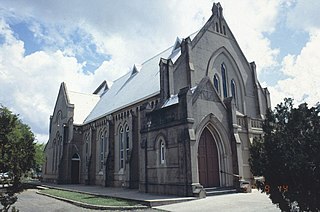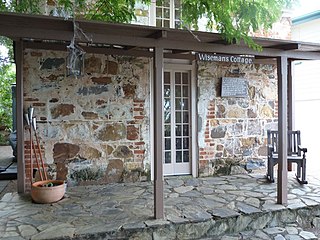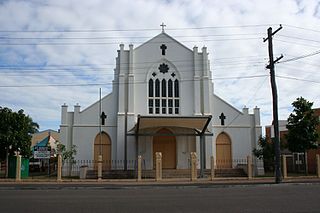
All Saints Anglican Church is a heritage-listed church at 32 Wickham Terrace, Spring Hill, City of Brisbane, Queensland, Australia. First founded in 1862, the current building designed by Benjamin Backhouse was completed in 1869, making it the oldest Anglican church in Brisbane. For most of its history, it has been identified with the High Church or Anglo-Catholic tradition within Anglicanism. It was added to the Queensland Heritage Register on 21 October 1992.

St Paul's Anglican Cathedral is an Australian heritage-listed cathedral at 89 William Street, Rockhampton, Rockhampton Region, Queensland. It was designed principally by Annersley Voysey and built from 1883 to 1953. It is also known as St Paul's Church of England and St Paul's Church of England Cathedral. It was added to the Queensland Heritage Register on 21 October 1992. The associated hall and offices were listed on the Queensland Heritage Register on 23 June 2000.

St Luke's Anglican Church is a heritage-listed church at 152 Herries Street, Toowoomba City, Queensland, Australia. It is the second church on the site and was designed by John Hingeston Buckeridge and built in 1897. It is also known as St Luke's Church of England. It was added to the Queensland Heritage Register on 28 July 2000.

St Mary's Anglican Church is a heritage-listed churchyard at 433, 447 & 449 Main Street, Kangaroo Point, Queensland, Australia. It was designed by Richard George Suter and built in 1873 by Alfred Grant. It was added to the Queensland Heritage Register on 21 October 1992.

St Agnes Anglican Church is a heritage-listed churchyard at Ipswich Street, Esk, Somerset Region, Queensland, Australia. It was designed by John Hingeston Buckeridge and built in 1889 by Lars Andersen. It is also known as St Agnes Rectory and Church Hall. It was added to the Queensland Heritage Register on 21 October 1992.

All Saints Memorial Church is a heritage-listed Anglican church at Tamrookum Church Road, Tamrookum, Scenic Rim Region, Queensland, Australia. It was designed by Robin Dods and built in 1915. It was added to the Queensland Heritage Register on 21 October 1992.

Old Bishopsbourne Chapel is a heritage-listed Anglican chapel at 233 Milton Road, Milton, City of Brisbane, Queensland, Australia. It was designed by Robin Dods and built in 1912 by Hall & Myers. It is also known as St Francis' Theological College Chapel and Chapel of the Holy Spirit. It was added to the Queensland Heritage Register on 21 October 1992.

St Mary's Church is a heritage-listed Roman Catholic church at 20 Merivale Street, South Brisbane, Queensland, Australia. It was designed by Simkin and Ibler and built from 1892 to 1929. It was added to the Queensland Heritage Register on 3 December 2004.

St Paul's Anglican Church is a heritage-listed Anglican church and columbarium at 554 Vulture Street East, East Brisbane, City of Brisbane, Queensland, Australia. It was designed by Atkinson & Conrad and built in 1924 by J Hood. It was added to the Queensland Heritage Register on 7 February 2014.

St Patrick's Church is a heritage-listed Roman Catholic church at 58 Morgan Street, Fortitude Valley, City of Brisbane, Queensland, Australia. It was designed by Andrea Giovanni Stombuco and built from 1880 to 1882 by John Arthur Manis O'Keefe. It was added to the Queensland Heritage Register on 21 October 1992.

Sacred Heart Cathedral is a heritage-listed Roman Catholic cathedral at 266 Stanley Street, Townsville CBD, City of Townsville, Queensland, Australia. It was built from 1896 to 1902 by Dennis Kelleher. It is also known as Church of the Sacred Heart. It was added to the Queensland Heritage Register on 21 October 1992.

St Paul's Anglican Church is a heritage-listed church at 124 Brisbane Street, Ipswich, City of Ipswich, Queensland, Australia. It was built from 1855 to 1929. It was added to the Queensland Heritage Register on 21 October 1992.

Our Lady Star of the Sea Church & School is a heritage-listed Roman Catholic church and school at Goondoon Street, Gladstone, Gladstone Region, Queensland, Australia. It was built from 1924 to 1950. It was added to the Queensland Heritage Register on 21 October 1992.

St Andrew's Presbyterian Church is a heritage-listed former Presbyterian church at 280 Bolsover Street, in the central business district of Rockhampton, Rockhampton Region, Queensland, Australia. The former church was designed by Voller & Graham in the Gothic Revival style and built from 1893 to 1926. The former church was added to the Queensland Heritage Register on 21 October 1992.

St Mark's Anglican Church is a heritage-listed former church at 36 Larnach Street, Allenstown, Rockhampton, Rockhampton Region, Queensland, Australia. It was designed by architect Louis Spier Robertson and was built in 1900. It was added to the Queensland Heritage Register on 28 July 2000.

Wiseman's Cottage is a heritage-listed storehouse at 30 Nathan Street, The Range, Rockhampton, Rockhampton Region, Queensland, Australia. It was built from c. 1857 to c. 1859. It is also known as Mount Athelstane. It was added to the Queensland Heritage Register on 21 October 1992.

St John's Anglican Church is a heritage-listed church at 278 Ford Street, Berserker, Rockhampton, Rockhampton Region, Queensland, Australia. It was built in 1912. It was added to the Queensland Heritage Register on 5 August 2003.

Nerimbera is a rural locality in the Livingstone Shire, Queensland, Australia. In the 2016 census, Nerimbera had a population of 293 people.

Christ Church Anglican Church is a heritage-listed church at Cannon Street, St Lawrence, Isaac Region, Queensland, Australia. It was designed by Alfred Mowbray Hutton and built in 1898 by Newman Brothers. It was added to the Queensland Heritage Register on 27 October 2000.

St Joseph's Church is a heritage-listed Roman Catholic church at Fryer Street, North Ward, City of Townsville, Queensland, Australia. It was designed by Charles Dalton Lynch and Walter Hunt and built from 1920 to 1921 by Joseph Rooney. It is also known as St Joseph on The Strand. It was added to the Queensland Heritage Register on 26 November 1999.


























